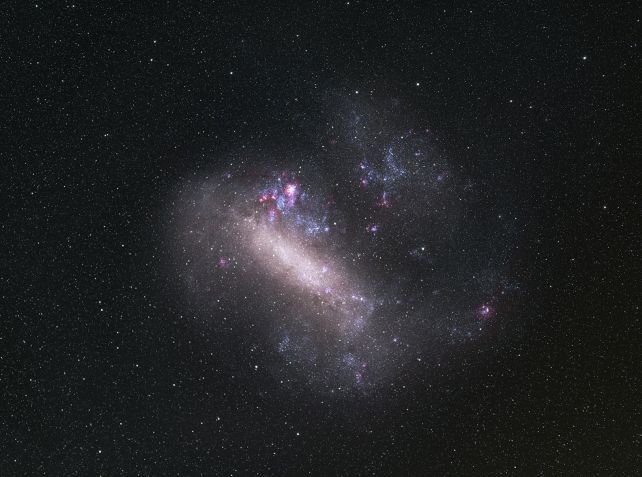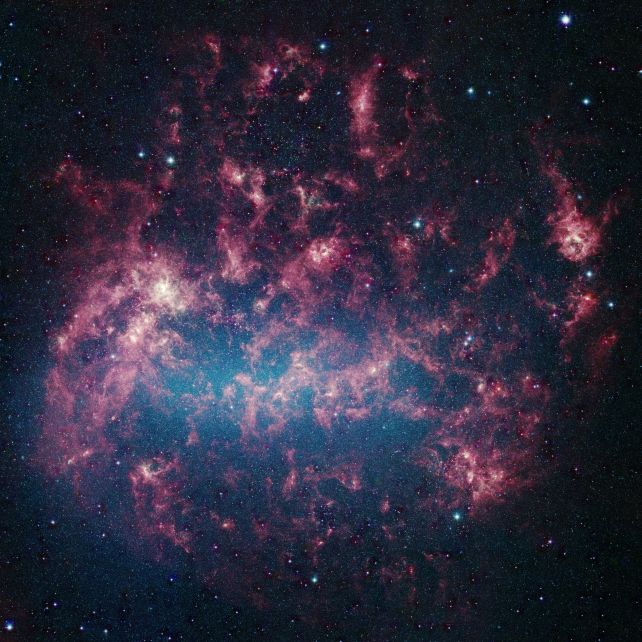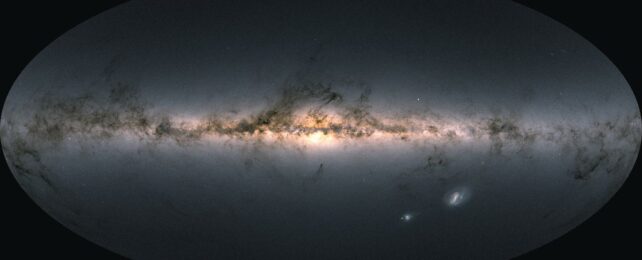A Milky Way collision with a supermassive black hole might be closer than we thought.
Hidden deep in the Large Magellanic Cloud dwarf galaxy that orbits the Milky Way on an ever-closing loop, signs of a massive invisible object clocking in at around 600,000 times the mass of the Sun have been detected.
Since the Large Magellanic Cloud will one day collide with our own galaxy, that means the black hole is also destined to come crashing in.
What's even more interesting is that the black hole falls into a mass regime rarely seen, under a million times the mass of the Sun. If its existence can be confirmed, it gives us a new datapoint for understanding how black holes grow from star-sized masses to chunky monsters equivalent to not just millions but billions of Suns' worth of mass.
The discovery, led by astrophysicist Jiwon Jesse Han of the Harvard & Smithsonian Center for Astrophysics (CfA), has been submitted to The Astrophysical Journal, and is currently available on preprint server arXiv.
Black holes can actually be pretty difficult to spot. Unless they're actively slurping up matter, a process that produces blazing light as the material is super-heated by friction and gravity, they emit no radiation we can detect.
That means scientists have to get tricky, and one of their tricks is to look for stars that are moving around in a way that can be explained no other way.

The primary method of doing this is to measure for unusual orbits. It was by carefully studying orbits in the center of the Milky Way, for example, that astronomers confirmed the existence and mass of Sagittarius A*, the supermassive black hole at the center of the Milky Way (it's about 4.3 million solar masses, if you're interested).
Han and his colleagues did not look for orbits, however. Instead, their research focused on another type of stellar motion: the hypervelocity star, anomalous objects that travel much faster than the average speed of other stars in their galaxy – so fast, they could even make a break for intergalactic space.
There are a number of these daredevil stars zooming through the galactic halo, destination unknown.
The way these stars are accelerated led the researchers to the notion that they might lead us to hidden black holes. That acceleration kick is known as the Hills mechanism, a three-body interaction between a black hole and two stars. Eventually, the gravitational dance will lead to a member of this triplet being forcefully yeeted across space at hypervelocity.
The recently retired Gaia space telescope spent several years in space mapping the objects of the Milky Way, including their positions in three-dimensional space (which is harder than you'd think), as well as their motions and velocities.
Armed with Gaia data, the researchers made a new analysis of 21 hypervelocity stars in the galaxy's outer halo that are consistent with the Hills mechanism. These stars are all of the B subtype, huge and hot, with relatively short lives, which means their high-speed journeys through space have to have been relatively short too.
This analysis involved tracking back the stars' velocity and motion to their point of origin, carefully ruling our other possible acceleration scenarios. They were able to confidently trace 16 stars. Seven of them originated close to Sgr A*, at the center of the Milky Way.
The remaining nine stars, however, appear to have come from the Large Magellanic Cloud. And together, they suggest ejection via the Hills Mechanism by an object that weighs around 600,000 solar masses – a hidden black hole lurking therein.

The Large Magellanic Cloud currently orbits the Milky Way at a distance of around 160,000 light-years. Its long, slow fall into our galaxy is not a straightforward affair, but an ongoing dance; a recent estimate puts the encounter at around 2 billion years away.
Once the two galaxies are merged, the supermassive hole in the Large Magellanic Cloud – if black hole there is – will make its way to the galactic center, where it will eventually, after many more eons, merge with Sgr A* to make an even bigger black hole.
Astronomers believe that this is one way that black holes can grow from relatively small sizes to even bigger ones. It would be so incredible to see that process slowly taking place, right here in our own galaxy – even if we're not going to be around to see the finale.
Future research, the team hopes, will help them confirm the existence and determine the properties of their fascinating new discovery.
The research, submitted to The Astrophysical Journal, is available on arXiv.
